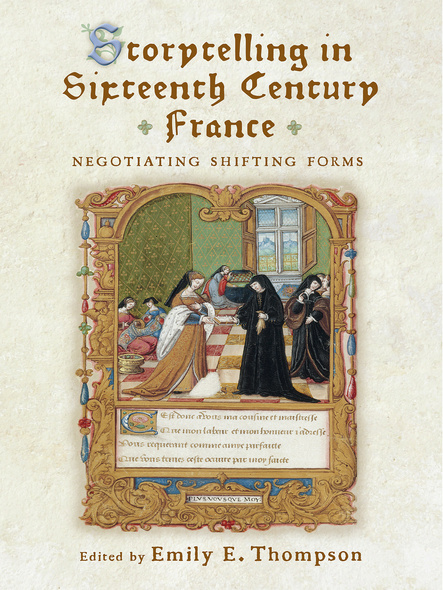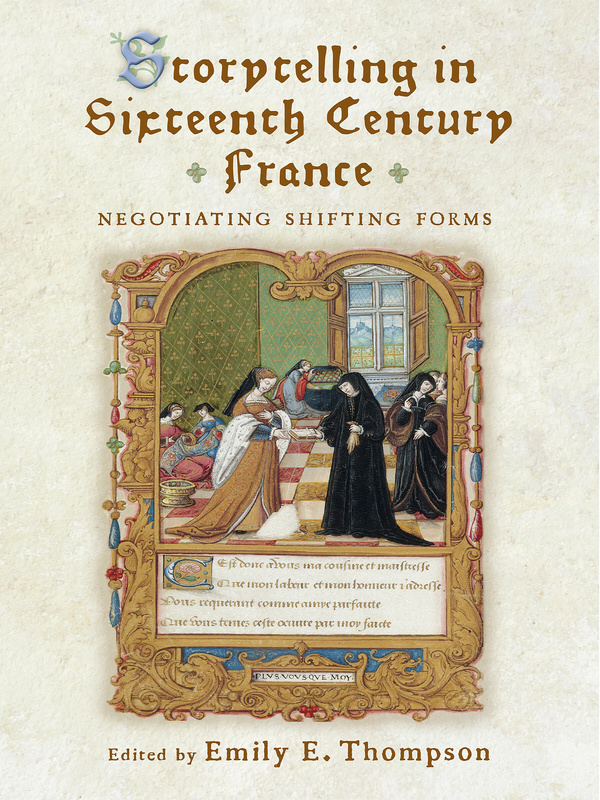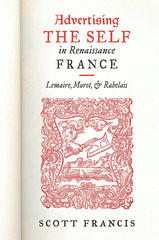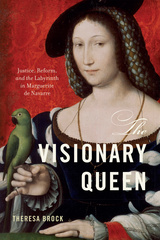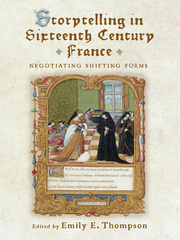Storytelling in Sixteenth-Century France
Negotiating Shifting Forms
Edited by Emily E. Thompson
SERIES:
The Early Modern Exchange
University of Delaware Press
Storytelling in Sixteenth-Century France is an innovative, interdisciplinary examination of parallels between the early modern era and the world in which we live today. Readers are invited to look to the past to see how then, as now, people turned to storytelling to integrate and adapt to rapid social change, to reinforce or restructure community, to sell new ideas, and to refashion the past. This collection explores different modalities of storytelling in sixteenth-century France and emphasizes shared techniques and themes rather than attempting to define narrow kinds of narrative categories. Through studies of storytelling in tapestries, stone, and music as well as distinct genres of historical, professional, and literary writing (addressing both erudite and more common readers), the contributors to this collection evoke a society in transition, wherein traditional techniques and materials were manipulated to express new realities.
Published by the University of Delaware Press. Distributed worldwide by Rutgers University Press.
Published by the University of Delaware Press. Distributed worldwide by Rutgers University Press.
EMILY E. THOMPSON is a professor of French and international studies in the Department of Global Languages, Cultures and Societies at Webster University in Webster Groves, Missouri. She contributed an article on Pierre Boaistuau’s edition of Histoires des Amans fortunez to the forthcoming collection Pierre Boaistuau ou le génie des forms and co-translated and co-edited Jeanne d’Albret’s Ample declaration with Kathleen Llewellyn and Colette Winn.
Emily E. Thompson, Introduction
Part I: Putting the Real into Words
Chapter 1. Amy Graves Monroe, “The Memorialist and the Historian: A Tale of Two Storytellers”
Chapter 2. Kathleen Loysen, “‘Ceste histoire veritable’: Women’s Narrative and Truth-Telling in the Comptes amoureux and the Angoisses douleureuses”
Chapter 3. Marian Rothstein, “The Queen’s Quandary: Storytelling in Jeanne d’Albret’s Ample Déclaration”
Chapter 4. David LaGuardia, “Telling the True and the Real in the Canards Sanglants”
Part II: Playing with Expectations
Chapter 5. Colette H. Winn, “Urania in Physician’s Robes or Poetry in the Service of Medicine: Girolamo Fracastoro, Syphilis sive morbus gallicus (1530)”
Chapter 6. JoAnn DellaNeva, “Storytelling at the Crossroads of Diplomacy, History, and Poetry: ‘The Story of the Death of Anne Boleyn, Queen of England,’ by Lancelot de Carle”
Chapter 7. Emily E. Thompson, “In Defense of Stories: Henri Estienne Reclaims the Story Collection for a New Readership”
Chapter 8. Dora E. Polachek, “Recasting the Heptaméron Novellas in Brantôme’s Vie des dames galantes”
Part III: Repurposing Stories through Shifting Forms
Chapter 9. Cathy Yandell, “Sex, Salvation, Extermination: Contrafacta and the French Wars of Religion”
Chapter 10. Sheila ffolliott, “Storytelling in Tapestry: Examples for a French Queen”
Chapter 11. Phillip John Usher, “The Night before Geology: Fossil Stories from Early Modern France”
Works Cited
About the Contributors
Part I: Putting the Real into Words
Chapter 1. Amy Graves Monroe, “The Memorialist and the Historian: A Tale of Two Storytellers”
Chapter 2. Kathleen Loysen, “‘Ceste histoire veritable’: Women’s Narrative and Truth-Telling in the Comptes amoureux and the Angoisses douleureuses”
Chapter 3. Marian Rothstein, “The Queen’s Quandary: Storytelling in Jeanne d’Albret’s Ample Déclaration”
Chapter 4. David LaGuardia, “Telling the True and the Real in the Canards Sanglants”
Part II: Playing with Expectations
Chapter 5. Colette H. Winn, “Urania in Physician’s Robes or Poetry in the Service of Medicine: Girolamo Fracastoro, Syphilis sive morbus gallicus (1530)”
Chapter 6. JoAnn DellaNeva, “Storytelling at the Crossroads of Diplomacy, History, and Poetry: ‘The Story of the Death of Anne Boleyn, Queen of England,’ by Lancelot de Carle”
Chapter 7. Emily E. Thompson, “In Defense of Stories: Henri Estienne Reclaims the Story Collection for a New Readership”
Chapter 8. Dora E. Polachek, “Recasting the Heptaméron Novellas in Brantôme’s Vie des dames galantes”
Part III: Repurposing Stories through Shifting Forms
Chapter 9. Cathy Yandell, “Sex, Salvation, Extermination: Contrafacta and the French Wars of Religion”
Chapter 10. Sheila ffolliott, “Storytelling in Tapestry: Examples for a French Queen”
Chapter 11. Phillip John Usher, “The Night before Geology: Fossil Stories from Early Modern France”
Works Cited
About the Contributors

